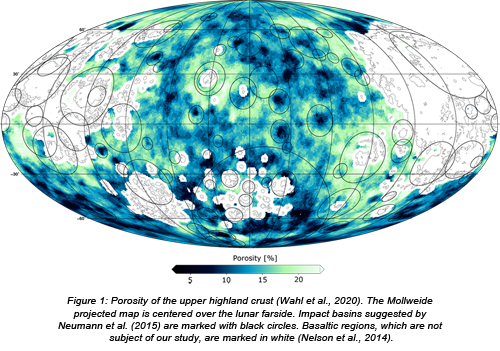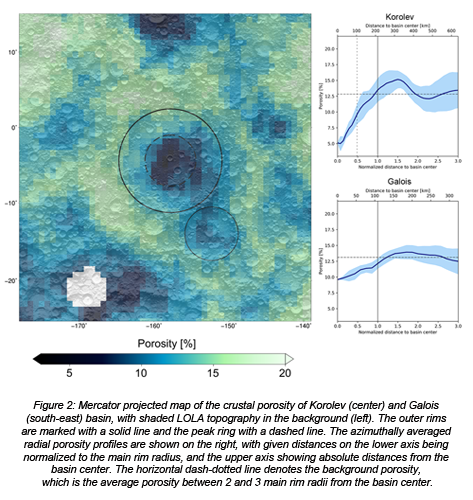Porosity Signature of Lunar Impact Basins
- 1Technische Universität Berlin, Department of Planetary Geodesy, Berlin, Germany
- 2Université Côte d'Azur, Observatoire de la Côte d'Azur, CNRS, Laboratoire Lagrange, Nice, France
- 3Museum für Naturkunde, Leibniz Institute for Evolution and Biodiversity Science, Berlin, Germany
- 4Freie Universität Berlin, Institut für Geologische Wissenschaften, Berlin, Germany
- 5German Aerospace Center (DLR), Department of Planetary Geodesy, Berlin, Germany
The upper portion of the lunar highland crust is known to show a wide range of porosities between 3 and 23% (Wieczorek et al., 2013). Impact cratering seems to be the primary mechanism for the porosity structure of the lunar crust as it can be observed today.
As demonstrated in previous work by Soderblom et al. (2015), impact cratering changes the initial porosity structure of the upper crust. Considering the Bouguer gravity signal of lunar complex craters, it was shown that preimpact porosity of the target material controls the magnitude of the postimpact Bouguer gravity anomaly. Impacts in targets with initially low porosity were found to result in a negative Bouguer anomaly (indicating a higher porosity after impact). In contrast, impacts in target materials with high porosity result in positive Bouguer anomaly (indicating a lower final porosity). To avoid the contribution of the gravity signal caused by the uplift of mantle material, their study concentrates on complex craters with diameters smaller than 200 km.
We compute a global map of crustal porosity in high spatial resolution (analysis region of 3° and grid size of 0.75°), using most recent Gravity Recovery and Interior Laboratory (GRAIL) mission gravity field model, developed to degree and order 1500 (Park et al., 2015). By filtering the long wavelength portion of the measured gravity signal, our results are independent from bending of the crust-mantle boundary, allowing us to investigate the porosity of impact basins with diameters larger than 200 km.
In a first step, bulk density was estimated by analyzing the correlation between Bouguer gravity and topography. Using only the short wavelength portion of the measured gravity field signal and applying a Bouguer correction (using the correct bulk density), the result should be uncorrelated with the surface topography. Testing different densities for calculating the Bouguer correction and minimizing the correlation with topography, the bulk density of each small analysis region is determined. Relating the bulk densities with independently obtained grain densities, lateral variations in porosity of the upper crust are determined (Figure 1). Since the lunar maria possess a complex interior structure, with dense basalts (originating most likely from the upper mantle) overlying the anorthosite crust, we omit locations of basaltic maria in our consideration.

Overall, we studied the porosity of 40 individual impact basins located in the lunar highlands. Specifically, we compute azimuthally averaged radial porosity profiles. For many basins, we found distinct porosity signatures, with regions of low porosity (i.e., high compaction) in their center and high porosity about one crater radius from the center. Larger basins are found to show a stronger pronounced porosity signature than smaller basins. Higher porosities could be explained by a more extensive fracturing of the target rock, caused by a stronger shock wave and/or a thicker blanket of excavated material during crater formation. Compact material in basin centers could be associated with larger quantities and depths of impact melt. Some basins show a less distinctive and muted porosity pattern, which we attribute to postimpact modification by superposed large basins and craters (Figure 2). Moreover, even though the data statistics are limited, we tentatively identify a correlation between the porosity structure of impact basins and their relative ages. While older candidates show a less pronounced porosity signature with a lower porosity contrast, younger basins show the highest porosities near their rims and the lowest values interior to the peak ring. We relate the lower contrast for older basins to modifications through later impact events. We suggest that after formation all basins show a pronounced porosity signature, which is erased later, by subsequent large-scale impact events.

References:
Nelson et al. (2014) Mapping lunar maria extents and lobate scarps using LROC image products. LPSC Abstract #2861.
Neumann et al. (2015) Lunar impact basins revealed by Gravity Recovery and Interior Laboratory measurements. Science Advances, 1(9), 1-10.
Park et al. (2015) A high resolution spherical harmonic degree 1500 lunar gravity field from the GRAIL mission. AGU Fall Meeting, Abstract #G41B01.
Soderblom et al. (2015) The fractured Moon: Production and saturation of porosity in the lunar highlands from impact cratering, Geophys. Res. Lett., 42, 6939–6944.
Wahl et al. (2020) Crustal porosity of lunar impact basins. Journal of Geophysical Research: Planets, 125, 1-14.
Wieczorek et al. (2013) The crust of the Moon as seen by GRAIL. Science, 339, 671-675.
How to cite: Wahl, D., Wieczorek, M., Wünnemann, K., and Oberst, J.: Porosity Signature of Lunar Impact Basins, Europlanet Science Congress 2020, online, 21 September–9 Oct 2020, EPSC2020-280, https://doi.org/10.5194/epsc2020-280, 2020

